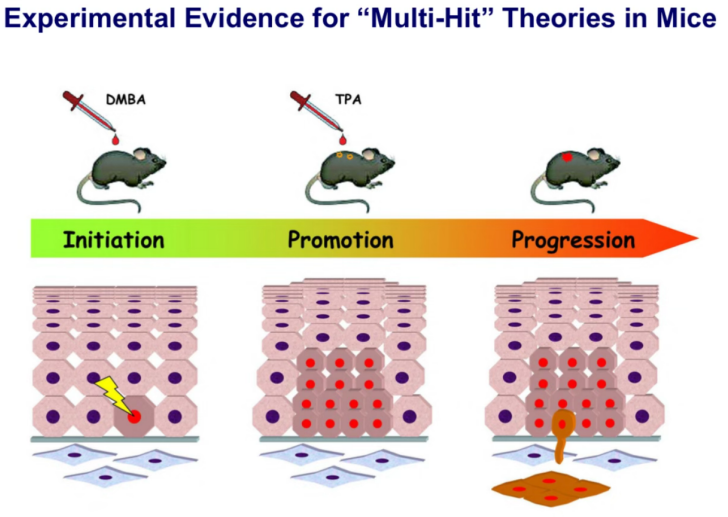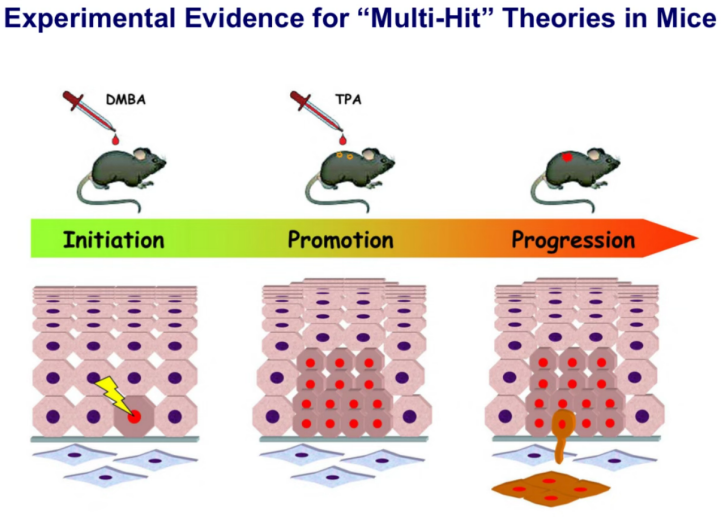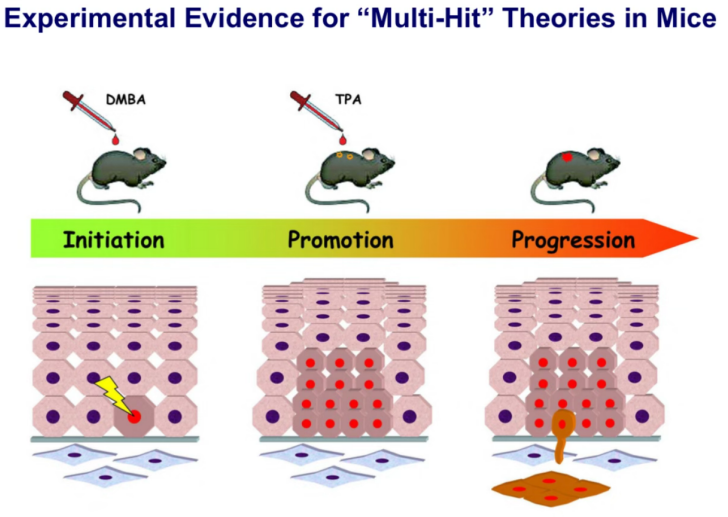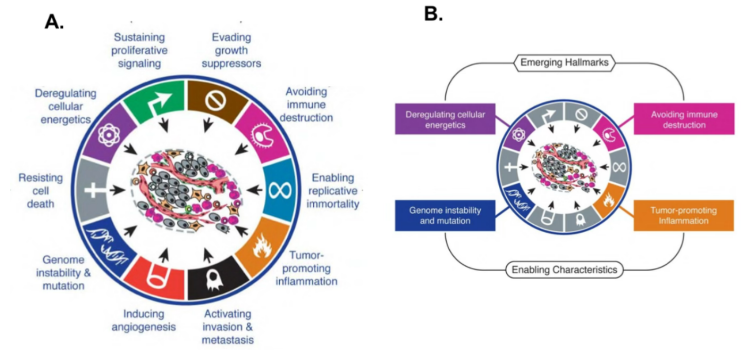Cancer & Treatment Part 1.5 (copy)
1/28
There's no tags or description
Looks like no tags are added yet.
Name | Mastery | Learn | Test | Matching | Spaced |
|---|
No study sessions yet.
29 Terms
What are the "Multi-Hit" Theories of Carcinogenesis and Metastasis
Cancer and its metastatic spread result from multiple genetic mutations (hits) accumulating over time, driving tumor formation and progression."
What is the Hayflick limit in the context of carcinogenesis
Finite number of population doublings (approximately 50 to 60) most cells can undergo, limited by telomeres—repetitive DNA sequences at chromosome ends that shorten with each division, leading to senescence."
How do cancer cells circumvent the Hayflick limit
"Cancer cells activate telomerase, a protein typically turned off after development, which extends telomere length, preventing shortening and allowing indefinite division, causing cell immortality."

What happens to cancer cells after bypassing the Hayflick limit
"Cancer cells may develop aneuploidy, where chromosomes are unevenly distributed during division, resulting in abnormal numbers—more or fewer than typical—leading to further mutations."
How does aneuploidy contribute to cancer progression
"Aneuploidy-induced genetic instability causes additional mutations in specific genes, driving increased proliferation, suppression of cell death, and enhanced immune evasion, advancing cancer."
What experimental model supports the "Multi-Hit" Theories
"The DMBA-TPA model in mice supports the 'Multi-Hit' Theories, demonstrating carcinogenesis through distinct stages of initiation, promotion, and progression."

What is the initiation stage in the DMBA-TPA model
"Initiation involves applying DMBA, a carcinogen, to mouse skin, inducing mutations in key genes like Ras and p53, critical for skin cell growth."

What is the promotion stage in the DMBA-TPA model
"Promotion follows with TPA treatment on the same skin area, stimulating growth of mutated cells and triggering inflammation, a necessary factor for cancer initiation."

What is the progression stage in the DMBA-TPA model
"Progression occurs as the growing tumor advances, providing experimental evidence for the multi-hit (or two-hit) model of cancer development."

How does chronic inflammation contribute to the DMBA-TPA model
"Chronic or recurrent inflammation, induced by TPA, is a necessary factor in initiating cancer, supporting tumor growth in the DMBA-TPA model."

How is tumor growth similar to Darwinian evolution
"Tumor growth resembles Darwinian evolution as cancer cells adapt to treatments, with surviving cells acquiring mutations to thrive in therapy-altered environments, evolving resistance."
What happens when a tumor shrinks after treatment
"When a tumor shrinks post-treatment, most cancer cells die, but surviving cells with additional mutations resist the therapy and continue adapting."
How do cancer cells adapt to changing conditions
"Cancer cells alter their genes through rapid mutations—faster than traditional evolution—to adapt to new conditions, such as treatment pressures."
Who authored the Hallmarks of Cancer
"Douglas Hanahan and Robert A. Weinberg authored the Hallmarks of Cancer, first in 'The Hallmarks of Cancer' (2000) and updated in 'Hallmarks of Cancer: The Next Generation,' Cell, 144, 646-674 (2011)."
What are the Hallmarks of Cancer according to Hanahan and Weinberg (2011)
"The Hallmarks are:
1. Sustaining proliferative signaling
2. Evading growth suppressors
3. Avoiding immune destruction
4. Enabling replicative immortality
5. Inducing angiogenesis
6. Activating invasion and metastasis
7. Resisting cell death
8. Deregulating cellular energetics
9. Tumor-promoting inflammation
10. Genome instability and mutation, with avoiding immune destruction and deregulating cellular energetics reiterated as key traits.

What does sustaining proliferative signaling mean
"Cancer cells generate their own growth signals to promote uncontrolled proliferation, independent of external cues."
What does evading growth suppressors mean
"Tumor cells ignore signals that normally inhibit growth, bypassing bodily controls to continue dividing."
What does avoiding immune destruction mean
"Cancer cells develop mechanisms to evade detection and destruction by the immune system, despite being slightly different from normal cells."
What does enabling replicative immortality mean
"Cancer cells overcome the Hayflick limit by activating telomerase, maintaining telomeres for limitless replication."
What does inducing angiogenesis mean
"Tumors stimulate new blood vessel formation to supply nutrients and oxygen, supporting sustained growth."
What does activating invasion and metastasis mean
"Cancer cells gain the ability to invade surrounding tissues and spread to distant sites, rewiring signaling pathways for mobility."
What does resisting cell death mean
"Tumor cells evade apoptosis and other programmed cell death mechanisms, enhancing their survival against natural checks."
What does deregulating cellular energetics mean
"Cancer cells alter their metabolism (e.g., increased glycolysis) to support rapid growth and survival, even in low-oxygen conditions."
What does tumor-promoting inflammation mean
"Chronic inflammation in the tumor microenvironment supports cancer progression by fostering a pro-tumor environment."
What does genome instability and mutation mean
"Increased mutation rates and genetic instability drive the acquisition of hallmark capabilities, accelerating cancer development."
What were the original six Hallmarks of Cancer in 2000
"The original six hallmarks (2000) were:
1. Evading apoptosis (avoiding programmed cell death)
2. Self-sufficiency in growth signals (proliferating without external factors)
3. Insensitivity to anti-growth signals (ignoring growth stops)
4. Tissue invasion and metastasis (spreading via rewired pathways)
5. Limitless replicative potential (overcoming Hayflick limit via telomerase)
6. Sustained angiogenesis (recruiting blood vessels)
How did the 2000 Hallmarks evolve by 2011
"The 2011 update expanded the original six hallmarks to ten, adding
Avoiding immune destruction,
Tumor-promoting inflammation,
Genome instability and mutation
Refining deregulating cellular energetics
as both a hallmark and enabling characteristic.
Why are the Hallmarks of Cancer significant
"The Hallmarks provide a unified perspective on cancer, identifying common processes across all types that can be targeted by specific therapeutic strategies."
How does avoiding immune destruction inspire therapy
"Avoiding immune destruction, a key hallmark, has spurred immuno-oncology therapies that unmask tumor cells, making them recognizable for immune destruction."